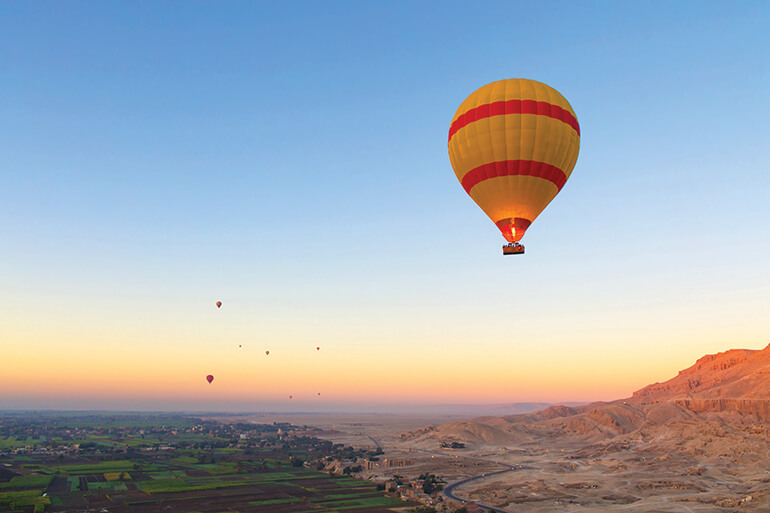
Destination Egypt Part 2: Is a Trip to Egypt for You?
This is the second installment of our two-part interview with Robyn and Branka about their trip to Egypt. To read more about the Great Pyramids, life in Cairo, and the hot-air balloon excursion (!), visit Destination Egypt Part 1: Our Cruise Report from the Valley of the Nile.
________________________________________________
How does this trip compare to a “typical” cruise?
R: Well, in my opinion, this isn’t a cruise. The Go Next Egyptian Wonders program mostly happens on land, and there’s a cruise component in the middle of it. You start in Cairo, fly to Luxor, then cruise on the MS Farah for four days on the Nile. After that, you fly to Abu Simbel and go back to Cairo and Alexandria. We even offer an optional extension to Jordan which is all land-oriented. Usually, Go Next programs are cruising from beginning to end. Here, we combine more land with a shorter cruise. So that’s how this trip is different.

Jordan Extension
What was the weather in Egypt like and what should a trip-goer pack?
Robyn: We had beautiful weather during our trip. Go Next will offer this trip at the same time next year, in February. It was in the low 70s most of the time. The key is to wear layers. It may get a little cool at night when the sun goes down, and sometimes in the morning. The best thing to do is travel lightly during the day and take a backpack. It rained one day, and it was a little windy some days, but mostly sunny. For me, the weather was perfect!
B: Yes, dressing in layers is essential for the warmer daytime and cooler evenings. The MS Farah was comfortable, and the river journey was very pleasant. February weather was perfect for daytime temperatures, and there were no bugs on the open deck! Egypt and Jordan are modern countries, so casual clothes are acceptable. Comfortable closed-toe shoes are a must, as opposed to sandals. I wish I would have brought a flashlight with me for the evening activities, like the Karnak Temple.
R: You’ll also want to take a scarf or something with you for covering up at some of the religious sites we visit. On our 2020 trip, we’ll enter a Mosque, an Islamic temple, and a Coptic church. In some of these places, you’ll remove your shoes, or you can purchase some shoe booties.
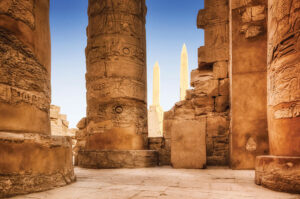
Karnak Temple, Luxor
Was there anything you were especially glad that you brought with you?
R: I’m glad I brought my hiking shoes, because I wasn’t going to. The terrain is rugged—it’s rocky, dusty, and sandy, so you need closed-toe shoes. I wore jeans and casual outdoor gear. When you’re packing, think: lightweight, breathable, and comfortable or adventure wear.
So, kind of pack like you’re going hiking?
R: Yes, exactly. I saw a lot of people who had long-sleeved, vented shirts. Some travelers wore the pants that zipped off into shorts. Many people used hiking poles and wore hats for the sun.
Was there anything besides your hiking shoes that you were glad you opted to bring?
R: I’d recommend taking multiple pairs of shoes. I brought hiking shoes and tennis shoes, and I switched between them daily. When I knew I would be climbing, I’d wear the hiking shoes. If I knew we’d be sightseeing in a museum, I wore my tennis shoes. I was also glad I brought my sunglasses! I saw one woman with a small pair of binoculars. The guide would point out certain hieroglyphics, and she would look up at the pillar with her binoculars. I don’t think you need a big pair, but I thought that was really smart. And Nordic walking poles could be helpful because the ground is uneven.
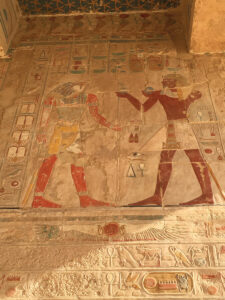
Hieroglyphics
Did you feel there was enough downtime to feel relaxed and rejuvenated after a long flight to Egypt?
B: At the beginning of our upcoming program, there will be a day to relax and have a good rest, providing you arrive early in the day. The following day is full speed ahead!
R: I think so. The first day is leisurely. The very next morning, the Egyptologist will meet with the group. During that orientation, they will go over all sorts of things from A to Z: water, food, currency, how to negotiate, security, and lots of other things that people need to know before the program starts.
The downtime usually comes at night. Once we got back from exploring Egypt for the day, we freshened up, had dinner, and got ready for the next day.
What was the food like?
B: On board, the food was a combination of international and Egyptian cuisine. There was a buffet breakfast and lunch, and an à la carte dinner. There was an array of local breads and spreads… hummus, muhammara, pickles. Egyptian pita bread was the one thing I will remember the best. Also [on the Go Next Extension], Jordan falafel in the street eateries are the world’s best!
R: Egyptian food is sort of Mediterranean style. I loved it! There was a lot of hummus, tahini, tomatoes and cucumbers, and vinaigrette salads. We ate some mezze plates—where they bring a spread of plates out. It’s a lot of food! And then they come out with your entrée. It’s a totally different way of eating.
So, like, courses?
R: Yes, but it all feels so healthy and good for you! Most of the restaurants have different courses. A lot of the lunches will be buffet lunches, but there will be a good mix of local, regional, and even American cuisine. But when you’re in Egypt, you definitely want to experience the local food!
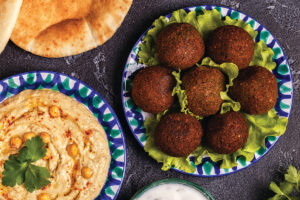
Falafel and hummus
Did you try anything new?
R: I tried lamb sausage and a lot of new sauces. The pita bread is amazing. Every meal we had was fantastic! And the local falafel was to die for. On the ship, they had everything. There was a bread station, a salad station, and entrées. They had a carving station and desserts and fruit. Everything was great and I never went away hungry.
Can you tell me a little bit about accommodations on board the MS Farah?
R: For people who are more familiar with ocean cruises, the MS Farah is smaller—around 100 guests. There are four decks plus a great sun deck. Everything is very close together… nice and clean and compact. It’s a modern, sleek ship. The staterooms are nicely furnished, and the crew is friendly.
B: Yes, the crew was exceptionally friendly, attentive, and interactive—both the cabin crew and the restaurant staff. There is very little downtime, but even that time is really taken up with constantly changing scenery along the shores of the Nile. The sun deck always seemed busy with guests. There was a cooking class one day and entertainment each evening.
R: The ship has everything you need, but you’re spending most of your day on shore exploring Egypt, so you’re not on the ship a whole lot of the time. If you want to have a drink in the lounge after dinner, you can do that and enjoy the nightly entertainment.
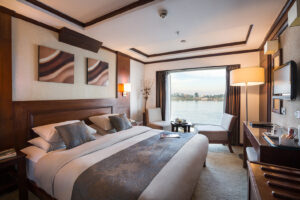
MS Farah cabin
So there was a calm atmosphere on board?
R: Yes. The most congregating happened outside on the sundeck. This is a pleasant place to hang out because there are teak tables and chairs—it’s a cabana feel. Every table has tied cabana-style curtains with tented tops. Being on the top deck, you can get as much or as little sun as you want. They have lounge chairs if you want to sit in the sun, and a pool. There’s also a telescope, blankets, and a little bar to get coffee or ice cream in the afternoon. When you’re on the sun deck, it feels like you’re right alongside the landscape, even with the land. It was nice to be up there and take pictures of the sunset.
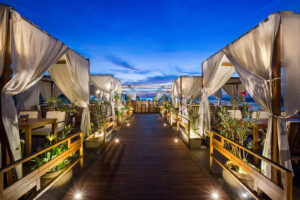
MS Farah sun deck
Do you feel like someone would need to have a certain level of fitness to be able to participate in this cruise?
R: I do. There’s a lot of walking. One day we took 13,000 steps before 11:00 in the morning! It’s going to be an action-packed trip. There will be early start times because there’s a lot to cover. This is a civilization that’s been around for over three thousand years! It’s a once-in-a-lifetime trip, so you want to get in as many things as you possibly can. You should know that there are no elevators anywhere except in the hotels. There aren’t any elevators in the ship or in the museums or any of the venues that we go to. There are a lot of steps, and some of them are uneven and broken.
B: The ancient sites all involve a good amount of walking, whether on the level paths, or up and down [sometimes high] steps, or in uneven terrain. There are also flights of steps and gangways to access the ship from the street level.
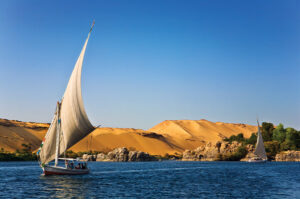
Feluccas on the Nile
It’s not really wheelchair accessible?
R: No, unfortunately not. Or accessible for motorized scooters. The trip has a lot of walking on gravel and rock and stone that’s inlaid in the ground. There are a lot of steps.
Who do you think this trip will appeal to?
R: There was a good, diverse group on our trip. People from all over the world. I think the type of person this trip will appeal to is maybe a more active person. Like the same kind of person who goes to Antarctica because “I’m checking this off my bucket list.” Egypt is in Africa, so… it’s another exciting continent people want to go to. This trip will also appeal to historians and people who like ancient civilization studies. People who want to see the Sphinx and the Great Pyramids and the temples.
Any last thoughts for someone considering a trip to Egypt?
R: It’s not like anywhere else I’ve ever been. The whole trip was incredible. If anyone is dreaming of experiencing Egypt’s extraordinary history and the magnificent landscape, don’t hesitate.
________________________________________________
If this Nile River adventure has inspired your wanderlust, come journey with us! Egyptian Wonders sails in February of 2020.